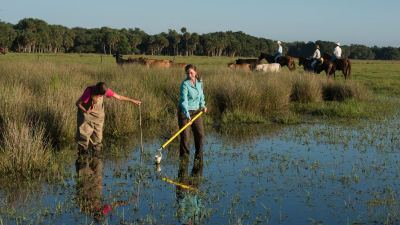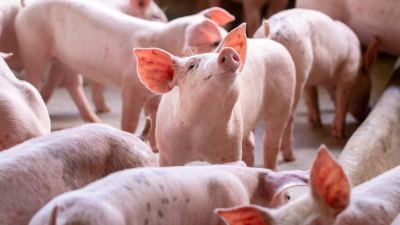Dr. Tom Rathje: Advanced genetics for improved swine production

DNA Genetics is the second largest provider of swine genetics in the North American market with a focus on the future of the pork industry.
Just how different are pigs today compared to twenty years ago? Dr. Tom Rathje, chief technical officer at DNA Genetics LLC, discusses his work with advanced technology in the swine industry and how commercial swine genetics has and continues to increase sow productivity and improve litter size.
The following is an edited transcript of Kara Keeton’s interview with Dr. Tom Rathje. Click below to hear the full audio.
Kara: I'm here today with Dr. Tom Rathje. He is the chief technical officer at DNA Genetics, the second-largest provider of swine genetics in the North American market. Thank you for joining me today, Tom.
Tom: Well, I'm very pleased to be here. It's been a very enjoyable couple of days.
Kara: Wonderful, wonderful. So, Tom, we're going to discuss today some advancements in swine technology within the industry. DNA Genetics has led the way in several different areas. Why don't you tell me a little bit about DNA Genetics and what your focus is as a company?
Tom: Yeah, I'd love to. DNA Genetics had its roots back in 1995, actually, is when we first got started, so we've been in the industry a long time. We've grown, over that time period, from a company that hadn't even sold one pig in 1995 to the second-largest supplier today.
I think a couple of very unique things about our company is that we are producer-owned, and what that gives us is a unique perspective as a genetic supplier, because our owner is a pig producer and they are certainly the first to let us know if there are any issues that we need to be challenged with. I think that brings that constant feedback that we need as a genetic supplier, so our focus is really on producing the best pig. If you look at the way our company has grown, it's grown through people trying our product. They do their own trials and they make their own decisions based on the economics. There's not a lot of hype or sexiness with that, but it's all about performance, and I think that stems from, I guess, our outlook on the industry. We're here to serve the producer.
Kara: And the producer wants a pig that will perform.
Tom: That's right.
Kara: So, in the 20-plus years that DNA Genetics has been producing quality stock, what have you seen evolve from the genetics side? How different is a pig from 20 years ago to today in the breeds you're using?
Tom: I'll answer that second question first. Certainly, the breeds have evolved. On the maternal side, we're still really focused on the Yorkshire and Landrace as the two dominant breeds, but we've seen a significant shift in at least the North American industry, and I think it's starting to happen worldwide toward the Duroc as a terminal line. I think a lot of that stems from the emphasis on export markets (and) higher-quality porks, so the Duroc breed will bring that over some of the other breeds that are out there. We've seen that change, and we are in a great position to take advantage of that in our growth, because we have a Duroc line that not only brings that meat quality but excels in performance.
I would say, when I first started — of course, this dates me a little bit — but in the '90s, we were still focused on producing a leaner pig. That's when packers first began to pay for carcass quality and leanness. That's really kind of ended, almost. I would say that, for the most part, we're being told the pigs are lean enough today. We don't need to put increased emphasis on reducing back fat, but it's starting to shift a little bit toward, I would say, more quality-oriented traits, and also, perhaps, if you're running a plant yield and some of those types of things that we've never looked at before, so that's been a significant change.
Obviously, another one is sow productivity. We've been very successful in improving litter size. Even the talk I gave here at the meeting (ONE: The Alltech Ideas Conference), we've improved litter size, and now, we need to get more of the pigs wean than we're already producing — so how does that shift our emphasis toward a quality of the pig that's being born, its ability to survive and thrive and go on to wean, and what type of a sow do we need to do that with? So, those are some of the big changes I've seen.
Kara: Does DNA Genetics' AccuGain Genetics Program fold into this development over the years and focus on the new direction for pork production?
Tom: I guess the way I would describe AccuGain is it's a commitment of our company to our customer, the producer. That program will, if you will, fold over the top of any type of trait or direction that we're going to go, so it's a commitment to having the discipline to implement the genetic program, measure the animals that we need to measure.
If I could elaborate on that in a minute, there aren't a lot of secrets in the genetic business. It takes large population size. There are no shortcuts to measuring the traits. For instance, birth weight is a trait. We've really looked hard, and that's part of our selection program, and you have to measure that on every pig. You can't do a litter; you can't do a few pigs here and a few pigs there. You have to commit to doing everything for every animal.
Really, AccuGain is that spirit of doing what it takes to produce the product, so whether it's collecting a phenotype, our database system called Helix that supports that, having the population size that we need. The larger your genetic nucleus, the more progress you can make, so we're committed to having a nucleus that's very competitively sized. All of those things wrap together at what AccuGain is all about. It's that commitment.
We use a lot of football analogies, and it's the blocking and tackling. You can have a great West Coast offense, you can have a great passer and receiver, but if you can't block and tackle, you're not going to be successful.
Kara: Well, DNA Genetics produces one of the most widely used terminal lines in the swine industry. It influences over 40% of the (total) pork production. How does it feel for you to know that your company, that you've worked with for over 20 years, has this much influence on the pork industry?
Tom: It's very humbling to think of the impact that that product has had, and it continues to grow. We, as a team, our company is really focused on teamwork and working together for the right outcome. I really believe that's a reflection of that effort to listen to our customer and produce the product that they need, and really, it's proof, if you will. The reason it's grown, as I mentioned earlier, is because people try the product. They evaluate it on their own economics and their own system, and it makes them more money. It makes them more sustainable. Again, it's very humbling. We want to continue to listen to our customers and make sure we're delivering what they need, but if I could point to the success of the product or the reason, those are it.
Kara: You talked about the company being a family business, owned by families. It's based in Nebraska, and you've grown throughout North America. What is your goal on a global scale? How are you growing beyond North America?
Tom: Well, our commitment with growth is that we're committed — our business is based in North America. As we've grown here, we have a commitment to our customers never to dilute their genetics or to grow beyond our means and ability to serve them, but having said that, we do have ambitions to continue to grow. We've started a business with a partner in Spain, so we have expanded there, and we'll certainly look at other opportunities around the world. We've moved into that one international market in Southern Europe. That's a new business. It's about a year and a half old, so it's just getting started, and we're excited to see what they're going to be able to do.
Kara: Well, as with all industries, technology has an impact, and that is especially true in the swine industry with the advancements in genetics. Why is it still a big dream to reach both a large litter size and have (adequate) birth weight? You mentioned both of these genetic traits earlier, and some people might wonder why you can't achieve both easily.
Tom: Well, there are challenges there. Litter size, in and of itself, is what we call a lowly heritable trait, so in order to make genetic improvement, you need to have large nucleus herds with lots of data, and you need to select those families accordingly, so it's taken us a long time. Litter size selection began in earnest, if you will, in the early '90s, and it's taken us a long time to build up the genetic potential that we see today. Today, we would have top producers that are capable of 17 and 18 pigs born alive on a pretty consistent basis. The talk that I gave today really addressed (the issue that) along with that litter size selection comes other challenges. As litter size goes up, on average, your pig birth weight goes down. That's highly related to survival.
Today, we're really in a situation with our top lines of having sows that produce enough pigs, but we really need to wean more of those pigs. We don't need more pigs. We need to wean more of what we already have. That's where birth weight comes into play. Litter size, to me, if I can make an analogy, is about what is the rate-limiting step. It used to be that pigs born was a rate-limiting step for a number of wean. I'd say, at least today, we're onto another rate-limiting step, which is quality and survivability, and we'll focus on that as well as some characteristics of the sow, like teeth count and milking ability, as well.
Kara: So, it appears (that) you have more research on these traits you're trying to reach. Are there any other research objectives you have ahead? Where do you see swine production needs or challenges five years, ten years down the road?
Tom: Well, I think one of the areas that is our customers' largest economic value trait — and, probably, largest loss — is just survival and mortality. As genetic suppliers, as a whole, we haven't paid a lot of attention to that. Typically, the herdabilities are nearly zero, so it's hard to find a place to make genetic improvement. I think, in the future, we'll be looking at, maybe, additional traits or additional ways or phenotypes that we can use to measure and find those animals that convey more robustness to our population's better survivability, so I would look for that (to) be coming. I would also look at the integration that's taking place between producers and packers. We saw packers move into hog ownership years ago. Now, we're seeing it go the other way as well.
Today, your average genetic suppliers — or most genetic suppliers — produce a pig that'll be essentially dropped off at the plant. I think that's going to change, where there'll be a value proposition for genetics within the plant down the road, so those are certainly areas that we need to be paying attention to. And then, of course, some of the other technologies that are exciting would be gene-editing, for example, to create animals that are resistant to various pathogens. Those technologies are really in their infancy. I would look for a number of years to go by before they're used routinely. I don't want to predict how many because, even today, we haven't figured out what the regulatory environment is, but there's certainly an exciting promise with some of that technology that will benefit the animals we work with, our customers, the producers and society as well.
Kara: It looks like DNA Genetics has lots still to look forward to in the growth of the business and the growth of the industry, so we thank you for coming and sharing with us today.
Tom: Thank you very much. I appreciate the time.
Kara: This was Dr. Tom Rathje, the chief technical officer at DNA Genetics.















